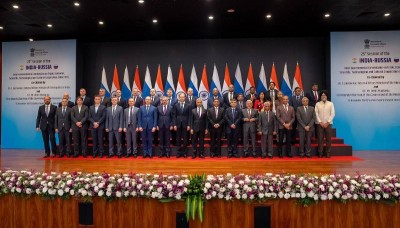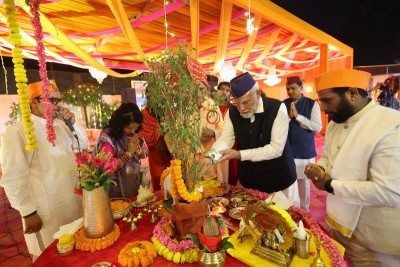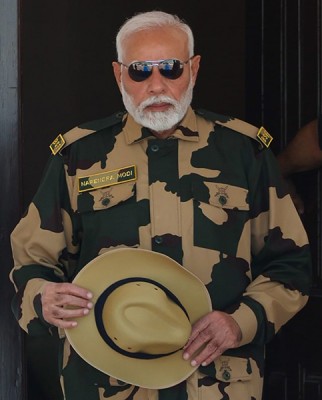
J&K: Political Defalcation
Following the recent trend of orchestrated and violent street protests during and after most encounters in parts of Kashmir Valley, violent demonstrations followed Wani's death. The magnitude of the violence, was, however, much greater, with at least 22 protestors and one trooper killed, and more than 200 persons, including 102 civilians and 100 SF personnel sustaining injuries since the protests began on July 8. Four Police Stations, 36 civil administration offices and dozens of vehicles were destroyed in the protests, which were still ongoing at the time of writing. In comparison, according to partial data compiled by the South Asia Terrorism Portal (SATP), 16 incidents of protests during and after encounters have been recorded since the beginning of 2016, resulting in three fatalities (all civilians) and 116 persons injured, including 87 civilians and 29 SF personnel.
The primary reason behind large scale violence following Wani's death was the projection by a section of the media of Wani as a 'cult figure', the image of a 'poster boy' for 'local militants'. Indeed, Imtiyaz Hussain, Senior Superintendent of Police (SSP) Baramullah, in his Facebook Post on Burhan Wani's killing, wrote on July 9, 2016,
*The truth is, despite all his "virtual" bravado, despite being a poster boy, he could not carry out a single action against security forces...!!!_*. His life #glamorized by #media power, and his death celebrated in same way... by people who just stand on sidelines, and cheer gleefully..."
Another reason for the large-scale violence was the failure of SFs to identify the potential areas of trouble at the early stages of the protests. Additional Director General (ADG) of the Jammu and Kashmir Police, Criminal Investigation Department (CID), S.M. Sahai thus observed, on July 9, "If you look at what happened. difficulty has come in isolated pockets on the fringes. All these incidents, if you notice, are not in the main area where you normally expect trouble." A day later he was more forthright:
We admit that our focus was not on some areas. We are seeing how it happened. We faced trouble from the outlying areas. Government buildings, Police Stations and Army camps were attacked in the areas we least expected trouble. The areas Police expected trouble were put under control.
Sahai added, "Now that we are aware of what has happened, we will definitely try to prepare for it," and on July 10, noted, "The situation as of now is better."
Significantly, 12 protestors died on July 9 and another six, who were injured in clashes on July 9, succumbed to their injuries the next day. Another five protestors, and one SF trooper, were killed in clashes on July 10.
The situation is likely to veer towards normalcy over time. Far more intensive and dispersed protests have been contained and eventually neutralized by SFs in J&K during the anti-Amarnath Yatra demonstrations of 2008, which resulted in 51 civilian fatalities; and the orchestrated stone pelting campaign of 2010 when around 112 persons were killed in the streets. Street violence backed by Pakistan's Inters-Services Intelligence (ISI) and its proxies are not new in Kashmir, and the current surge has the hallmarks of past campaigns.
What is worrying, however, is the utter failure of the political class to learn lessons and its persistence with inept policies in dealing with the situation on the political front, despite extraordinary gains delivered by the operational successes of the SFs, and a dramatic decline in the intensity and spread of the insurgency.
For instance, 634 persons facing stone-pelting charges were given amnesty on the occasion of Eid, with the State Government approving withdrawal of 104 cases against them on July 5, 2016. Significantly, the decision of the State Home Department approving withdrawal of the cases came after Chief Minister Mehbooba Mufti gave instructions for the review of such cases pertaining to the period between 2008 and 2014, and the setting up of a three-member Committee for this purpose. The Committee reviewed cases for the period between 2008 and 2009 in the first phase and recommended the withdrawal of the 104 cases registered during this period. The Committee has sought another three weeks to review the cases pertaining to the 2010-2014 period. In a similar move in 2013, the previous Omar Abdullah Government had released 1,811 persons involved in cases of stone-pelting in the Valley during the 2010 summer unrest under its amnesty scheme.
Though the successive state Governments have argued that these actions are part of confidence building measures, the ground situation demonstrates their failure to deal with ground realities, and the fact that the released miscreants overwhelmingly return to their campaigns of street violence, exacerbating tensions and eroding the gains on the security front.
Significantly, according to National Crime Records Bureau (NCRB) data, there were 662 incidents of Police firing recorded in J&K during 2010, in which 91 civilians were killed and another 494 were injured. The number of incidents of firing came down to 132 in 2011, resulting in just 12 injuries to civilians; and further down to 103 incidents, though the resultant civilian deaths stood at seven, and another 33 were injured. In 2013, after the amnesty to 1,811 stone pelters from the 2010 campaign, the number of incidents of SF firing witnessed a quantum jump, to 318, with five civilian deaths and 49 injured. Though no incident of firing was recorded by NCRB through 2014, 304 incidents of lathi-charge (there was no data on lathi-charges in earlier years) in which one civilian was killed and another 138 were injured. Clearly, most of these police actions were presumably taken against protestors who were engaging in stone-pelting and other manifestations of street violence.
Unfortunate political decisions and a proclivity to resort to polarizing identity politics on the part of most significant political formations active in the State have undermined the hard won gains by the SFs in the face of Islamabad's continuous efforts to reverse thetrend of declining terrorism. Terrorism-related fatalities in the first six month and 10 days of 2016 stand at 120, but include just five civilians; 30 SF personnel and 85 terrorists have also died. In 2015, there were 78 fatalities during the corresponding period, including 12 civilians, 22 SF personnel and 44 terrorists. The SFs have succeeded in creating a safer environment for civilians, even as they have paid a higher price themselves, while, at the same time, securing a better kill-ratio against the terrorists.
The politics of opportunism is keeping J&K on a boil well after terrorism has lost strength and the base it had. The cycles of disruption will continue to recur periodically unless the remaining distance to normalization is covered by political initiatives. SF's can contain or end violence; they cannot create peace; that is the task of political sagacity, of which there is a visible and endemic deficit, both in the state and in the nation at large.
Support Our Journalism
We cannot do without you.. your contribution supports unbiased journalism
IBNS is not driven by any ism- not wokeism, not racism, not skewed secularism, not hyper right-wing or left liberal ideals, nor by any hardline religious beliefs or hyper nationalism. We want to serve you good old objective news, as they are. We do not judge or preach. We let people decide for themselves. We only try to present factual and well-sourced news.







